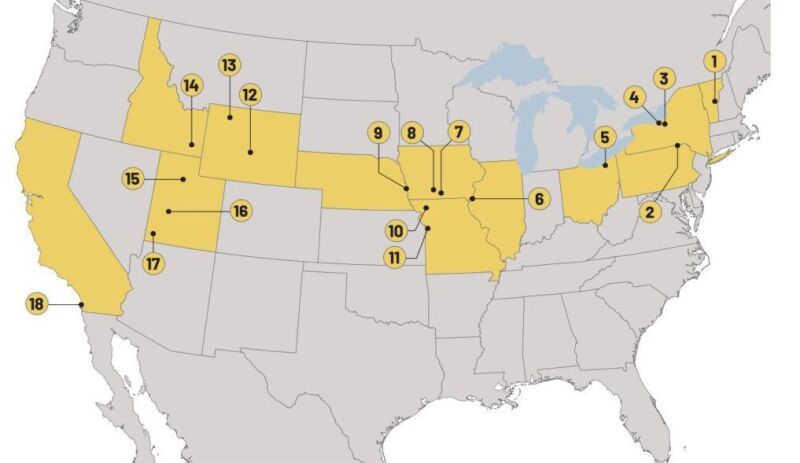Whether you’re traveling or simply want to know more about some of the significant Church history sites you’ve heard about in Sunday School and seminary, this guide, based on pages and information from the Church History Department, will answer all your questions! Follow the trail west as you pick a state from the list below and learn about all the historic Church sites in that area.
*Note: All of the places highlighted in this article with the exception of the Kirtland Temple and three sites in Nauvoo are owned by The Church of Jesus Christ of Latter-day Saints and have been dedicated by prophets and apostles. All played a significant role in the Restoration.
Vermont
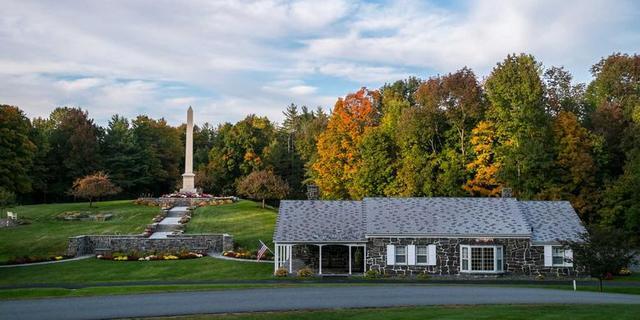
We start with the place where the Prophet Joseph Smith was born. Here, in Sharon, Vermont, Joseph was born on a farm owned by his grandfather, Solomon Mack. For the 100th anniversary of the prophet’s birth, a 38.5-foot monument, with each foot representing a year of Joseph Smith’s life, was erected. The site also hosts a visitors’ center that displays the original hearthstone from the Smith home and stones from the home’s original doorstep.
For more images, history, travel tips, location, hours, and other information, visit history.churchofjesuschrist.org.
New York
New York. We might call it the place where the Restoration truly began. Here you will find the Joseph Smith Family Farm and behind it the Sacred Grove, where Joseph first prayed and saw Heavenly Father and Jesus Christ. At this site, you will find a reconstructed log home and paths that allow you to spend quiet time in the Sacred Grove. A short drive away you will find the Peter and Mary Whitmer farm, where Joseph Smith finished translating the Book of Mormon and, perhaps most notably, where The Church of Jesus Christ of Latter-day Saints was officially organized.
In addition to these historic New York sites, you can also journey down the road to the Hill Cumorah, where the angel Moroni showed Joseph Smith the ancient record that would become the Book of Mormon. If you go at the right time of year, you can also catch the Hill Cumorah Pageant, which is put on by hundreds of volunteers and recreates scenes from the Book of Mormon. You can also take a jaunt down to the Book of Mormon Historic Publication Site (also known as the Grandin Building), where E.B. Grandin first published the Book of Mormon.
Additional sites you may want to visit if you have time include the Palmyra New York Temple, Alvin Smith’s gravesite, Martin Harris’s farm, and the Erie Canal.
For more images, history, travel tips, location, hours, and other information, visit history.churchofjesuschrist.org.
Pennsylvania
A little over 100 miles away from the New York historic sites, in Oakland Township, Pennsylvania, is the Priesthood Restoration Site—the location where the Aaronic Priesthood was restored. Two reconstructed homes and several monuments are part of this site, and nearby you can visit the McCune Cemetery where Joseph and Emma’s firstborn son is buried along with Emma’s parents.
For more images, history, travel tips, location, hours, and other information, visit history.churchofjesuschrist.org.
Ohio
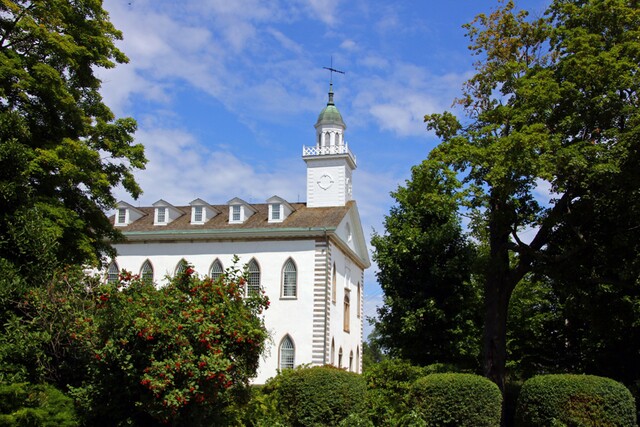
As we move west, you can visit several special places in Ohio. Biggest, perhaps, is the Kirtland Temple. Though no longer owned by The Church of Jesus Christ of Latter-day Saints, the Community of Christ does provide tours for a small fee to help with the building’s upkeep. You can also take a trip to historic Kirtland and visit the Newel K. Whitney store, along with other historic places. A short drive away in Hiram, Ohio, you can visit the home of John Johnson, which is where many significant revelations were received and where Joseph was dragged from his bed by a mob and tarred and feathered.
For more images, history, travel tips, location, hours, and other information, visit history.churchofjesuschrist.org.
Missouri
Continuing on, Missouri has many sites for those interested in Church history. From the Independence visitors’ center, built where Zion was once planned to be established, to Liberty Jail, where Joseph and others were imprisoned for around four months, there are several great places to explore history. Stop by the Far West temple site, have a picnic in the place that Joseph Smith declared as Adam-ondi-Ahman, stop and see Hawn’s Mill, or visit monuments commemorating the three and eight witnesses of the Book of Mormon.
For more images, history, travel tips, location, hours, and other information, visit history.churchofjesuschrist.org.
Illinois
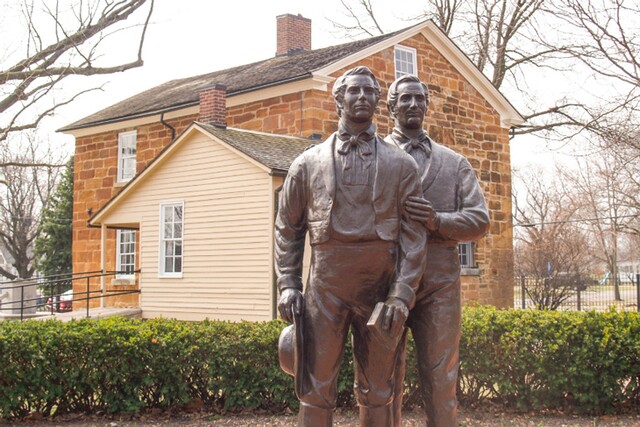
A prominent stop along the Mormon trail is Historic Nauvoo, home of the beautiful reconstructed Nauvoo Temple and the nearby restored Carthage Jail, where Joseph Smith and Hyrum were martyred. In Historic Nauvoo, stop by the reconstructed homes of Brigham Young, Sarah Granger Kimball, or John Browning and participate in demonstrations and hands-on activities. You may also want to stop and visit the graves of Joseph and Emma Smith, Hyrum Smith, Joseph Smith Sr. and Lucy Mack Smith, along with other Smith family members and early Latter-day Saints in two local cemeteries. The Community of Christ, which manages the Smith Family Cemetery, also maintains the Red Brick Store (where the Relief Society was organized, among other things) and the Mansion House, where Emma lived after the Saints traveled west. Admission to the store is free, and the other sites maintained by the Community of Christ can be visited for a small fee.
For more images, history, travel tips, location, hours, and other information, visit history.churchofjesuschrist.org.
Iowa
Another place to plan a visit is the state of Iowa. Spend some time at the Church’s first historic site: Mount Pisgah. Explore interesting pioneer stops along the trail between Nauvoo, Illinois, and Winter Quarters, Nebraska. Take some time at the Kanesville Tabernacle learning about the Mormon Battalion and visit the Battalion’s mustering grounds a short distance away. If you’re up for a few hours’ drive, you can also stop by Garden Grove, where some of the first pioneer settlements along the trail west were established.
For more images, history, travel tips, location, hours, and other information, visit history.churchofjesuschrist.org.
Nebraska
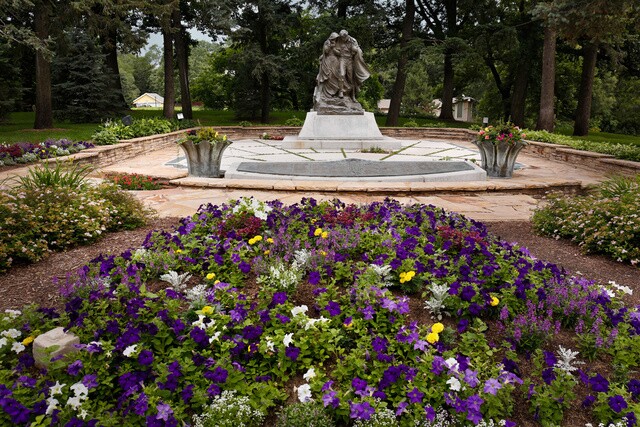
On your journey, don’t miss an opportunity to stop by the Winter Quarters Nebraska Temple and interact with exhibits, artwork, etc. at the Mormon Trail Center. You’ll also have the chance to see beautiful commemorative sculptures created by talented Mormon sculptor Avard Fairbanks at the Mormon Pioneer Cemetery.
For more images, history, travel tips, location, hours, and other information, visit history.churchofjesuschrist.org.
Wyoming
Leaving the more established settlements, we continue moving along the trail west, highlighting several of the significant Mormon handcart pioneer sites. Tour the Mormon handcart visitors’ center before you walk to Martin’s Cove, pulling a handcart part of the way if you desire.
You can also stop by Sixth Crossing, where rescuers saved the Willie handcart company during their sixth crossing of the Sweetwater River, or explore Rock Creek Hollow, where 15 members of the Willie handcart company died after crossing Rocky Ridge. There are also a number of other historic sites and visitors’ centers to see along the way, including Devil’s Gate, Fort Seminoe, Sun Ranch, and Prairie Park. Find more details about each of these places here.
For more images, history, travel tips, location, hours, and other information, visit history.churchofjesuschrist.org.
Utah
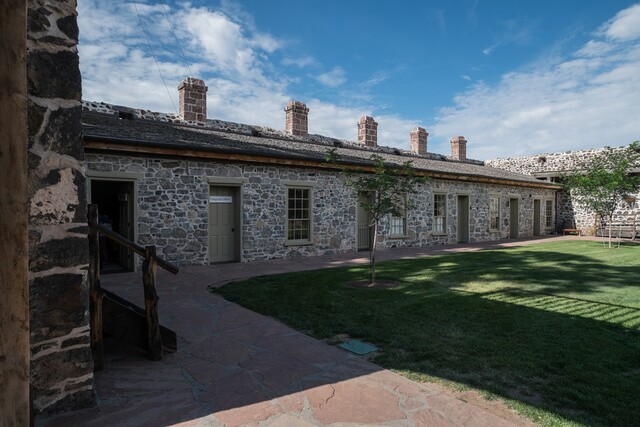
While there are dozens of pioneer sites in where the pioneers settled in Utah (check out Ensign Peak, Temple Square, the Beehive House, and the Salt Lake Cemetery, to name a few), Cove Fort was settled by ancestors of President Hinckley: Ira N. Hinckley and family. It was meant to protect telegraph lines and travelers on their way to and from Salt Lake City from the southern part of the state. It’s a great place to stop for a picnic and a tour of the fort, garden, blacksmith shop, corral, barn, and bunkhouse on your way to St. George.
In St. George, you can stop by the St. George Utah Temple and visitors’ center, Brigham Young’s Winter Home, the historic St. George Tabernacle, and the Jacob Hamblin Home among other nearby places such as the Mountain Meadows Massacre historic landmark, the Pine Valley chapel, and temple quarries.
For more images, history, travel tips, location, hours, and other information, visit history.churchofjesuschrist.org.
California
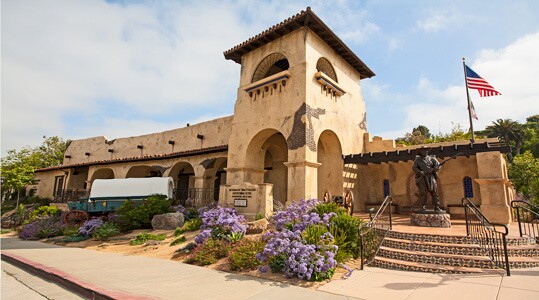
On the other side of the country, we come to the end of our historic Church sites. In San Diego, explore the Mormon Battalion visitors’ center, which commemorates the 500-person battalion’s historic march from Iowa to California. After watching gold panning and brickmaking demonstrations, walk across the street to the Old Town San Diego State Park for additional historical attractions, restaurants, stores, and entertainment.
For more images, history, travel tips, location, hours, and other information, visit history.churchofjesuschrist.org.
► You may also like: The Mormon Battalion: Recent discoveries help unravel mysteries after 175 years

